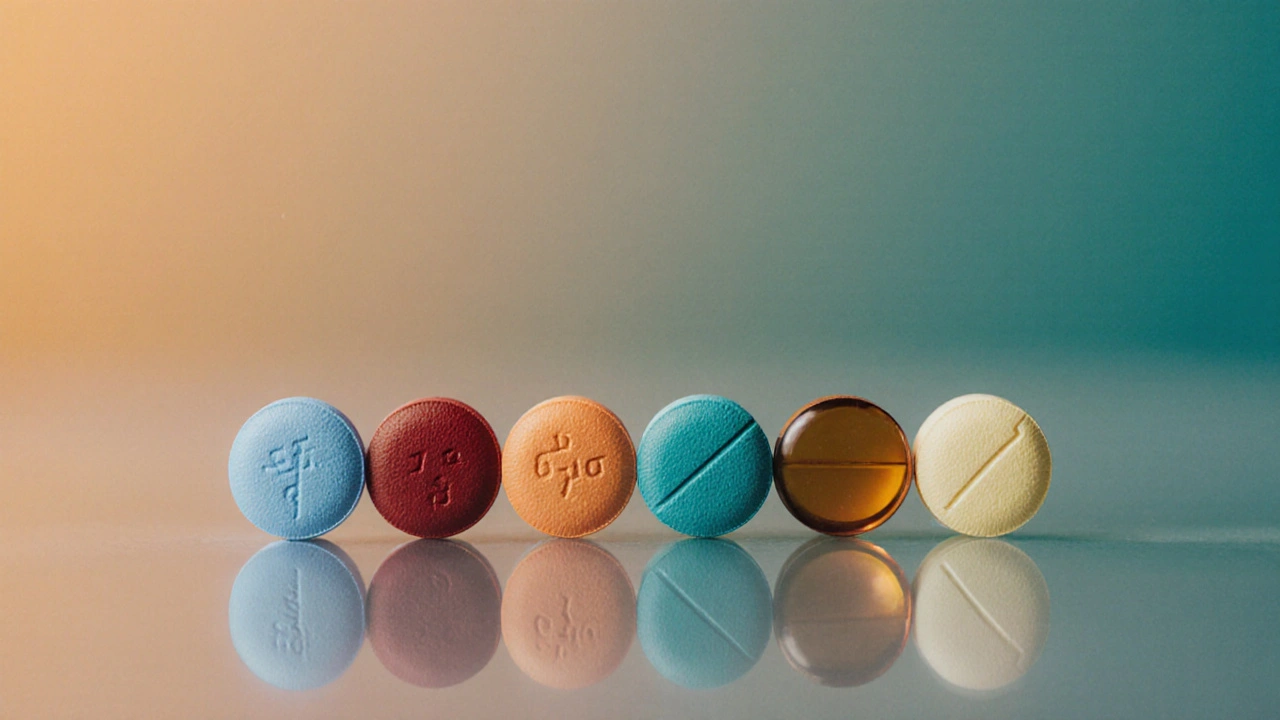Steroid Equivalence Calculator
Dose Conversion Calculator
If you’re weighing Omnacortil against other steroids, you probably want to know which drug will calm inflammation fastest, cause the fewest side‑effects, and fit your lifestyle. In the next few minutes you’ll get a clear rundown of Omnacortil (prednisolone) and the most frequently prescribed alternatives, plus a handy decision table to help you pick the right one.
Key Takeaways
- Omnacortil (prednisolone) is a mid‑potency oral glucocorticoid with a half‑life of 2-3hours.
- Methylprednisolone offers slightly higher anti‑inflammatory power and is often used for short‑term bursts.
- Dexamethasone is a high‑potency steroid with a long half‑life, ideal for severe or chronic conditions but carries higher risk of bone loss.
- Hydrocortisone is the weakest option, usually reserved for adrenal insufficiency or mild skin inflammation.
- Budesonide’s high first‑pass metabolism makes it a gut‑friendly choice for asthma or IBD, with fewer systemic effects.
What is Omnacortil (Prednisolone)?
Omnacortil is the commercial name for prednisolone, a synthetic glucocorticoid that mimics the body’s natural cortisol. It works by binding to intracellular glucocorticoid receptors, switching off inflammatory genes and reducing immune‑cell activity. Typical oral doses range from 5mg to 60mg per day, depending on the condition treated.

How Corticosteroids Work
Corticosteroid refers to a broad class of hormones that regulate metabolism, immune response, and stress. When you take a synthetic version, it enters cells, attaches to the glucocorticoid receptor, and travels to the nucleus where it either promotes anti‑inflammatory proteins or suppresses pro‑inflammatory cytokines. This mechanism explains why steroids can help everything from asthma attacks to rheumatoid arthritis, but also why they can raise blood sugar, thin skin, and affect mood.
Common Alternatives to Prednisolone
Below are the most widely used oral or inhaled steroids that doctors consider when prednisolone isn’t ideal.
- Methylprednisolone - 1.25× the potency of prednisolone, often given as a short‑term “pulse” for severe flares.
- Dexamethasone - high potency, long half‑life (36‑72h), useful for brain edema or COVID‑19 protocols.
- Hydrocortisone - lowest potency, identical to natural cortisol, typically used for adrenal crisis or mild eczema.
- Budesonide - high first‑pass metabolism (≈90% destroyed in liver), making it a “lung‑friendly” inhaled option or an oral formulation for inflammatory bowel disease.
- Prednisone - a pro‑drug that the liver converts to prednisolone; dosing is interchangeable but may be preferred for patients with kidney issues.
Side‑Effect Profile at a Glance
All corticosteroids share a core set of adverse effects, but the frequency and severity scale with potency, dose, and treatment duration.
| Drug | Relative Potency | Half‑Life (hrs) | Typical Uses | Key Risks |
|---|---|---|---|---|
| Omnacortil (Prednisolone) | 1× | 2-3 | Rheumatoid arthritis, asthma, skin disorders | Weight gain, glucose rise, mood swings |
| Methylprednisolone | 1.25× | 2.5-4 | Painful flares, MS relapses, transplant prophylaxis | Higher infection risk, insomnia |
| Dexamethasone | 25× | 36-72 | Severe COVID‑19, brain edema, chemotherapy anti‑nausea | Severe osteoporosis, adrenal suppression |
| Hydrocortisone | 0.25× | 1.5-2 | Adrenal insufficiency, mild dermatitis | Less systemic impact, but requires multiple daily doses |
| Budesonide | ≈1× (systemic), higher local | 2-3 (oral); 4-6 (inhaled) | Asthma, COPD, Crohn’s disease | Oral candidiasis, throat irritation |
| Prednisone | 1× (converted to prednisolone) | 2-3 | Identical to prednisolone, often used in renal patients | Same as prednisolone, plus occasional liver‑conversion variability |

Choosing the Right Steroid for Your Condition
When you sit down with a doctor, ask about these three decision criteria:
- Potency vs. Duration: For a rapid, high‑intensity flare, dexamethasone’s long half‑life can reduce dosing frequency. For chronic low‑grade inflammation, a milder agent like hydrocortisone or budesonide minimizes long‑term bone loss.
- Route of Administration: Inhaled budesonide targets the lungs directly, sparing the gut and bones. Oral prednisolone reaches the whole body but carries systemic exposure.
- Patient‑Specific Factors: Age, diabetes, osteoporosis risk, and liver/kidney function all tilt the balance. Older adults often get the lowest effective dose, while athletes may prefer budesonide for its limited performance impact.
Below is a quick decision tree you can sketch on a napkin:
- If you need quick, strong suppression → consider Dexamethasone.
- If you need moderate, oral control → Omnacortil or Prednisone (same effect).
- If you want short bursts with high potency → Methylprednisolone pulse therapy.
- If you prefer local action with minimal systemic load → Budesonide inhaled or oral.
- If you have adrenal insufficiency or need the weakest effect → Hydrocortisone.
Practical Tips & Common Pitfalls
- Never abruptly stop a high‑dose steroid. Taper by 5-10mg every 3-5days to let your adrenal glands recover.
- Take the tablet with food to reduce stomach irritation; a calcium‑vitaminD supplement can protect bone density.
- If you’re on a diabetes regimen, monitor blood glucose daily for the first two weeks - steroids can raise levels dramatically.
- Watch for mood changes. Around 10% of patients report insomnia or “steroid‑induced euphoria”. Report any severe anxiety to your clinician.
- For inhaled budesonide, rinse your mouth after each use to avoid oral thrush.
Frequently Asked Questions
Can I switch from Omnacortil to another steroid without a doctor?
No. Each steroid has a specific potency and half‑life. Switching without supervision risks under‑treatment or severe side‑effects. Always discuss tapering or substitution with your prescriber.
Is prednisolone stronger than dexamethasone?
Actually, dexamethasone is about 25 times more potent than prednisolone. That’s why the dose is much lower (e.g., 4mg dexamethasone ≈ 100mg prednisolone).
What’s the safest steroid for a pregnant woman?
Low‑dose hydrocortisone or prednisolone is generally considered safest because they closely mimic natural cortisol. High‑potency steroids like dexamethasone are avoided unless absolutely necessary.
How long can I stay on budesonide?
Because budesonide is largely metabolized in the liver, many patients stay on it for months to years for asthma or IBD, but regular bone‑density checks are still advised.
Do steroids cause weight gain even at low doses?
Even low doses can increase appetite and cause modest weight gain. Pairing the medication with a balanced diet and light exercise can mitigate the effect.


Stephanie Zuidervliet
October 12, 2025 AT 17:22Oh my goodness!!!, this post is a *symphony* of steroid facts, a whirl of potency tables, side‑effect warnings, and dosing calculators, and honestly-who even reads all that?!
Olivia Crowe
October 18, 2025 AT 23:22Honestly, I’ve been lost in steroid choices for years, and stumbling upon this guide feels like a breath of fresh air-keep it up!
Aayush Shastri
October 25, 2025 AT 10:55Growing up in India, I often saw relatives juggling oral prednisolone for asthma and the occasional dexamethasone burst for severe infections, so a clear side‑by‑side chart like this instantly reminded me of those kitchen‑table discussions where we tried to balance efficacy against side‑effects while keeping the family’s budget in mind.
It’s great to see the cultural nuances reflected in the dosing suggestions.
Quinn S.
October 31, 2025 AT 14:08In accordance with academic standards, the presented equivalence ratios warrant a more rigorous citation of peer‑reviewed pharmacokinetic studies; the current table, while visually appealing, omits critical confidence intervals, thereby potentially misleading clinicians who rely on absolute conversions without acknowledging inter‑patient variability.
Dilip Parmanand
November 6, 2025 AT 22:55From my experience, grasping the potency hierarchy of glucocorticoids is the first step toward safe tapering, and this tool makes that hierarchy instantly accessible.
Sarah Seddon
November 13, 2025 AT 04:55When I first tried to compare methylprednisolone pulses with oral prednisolone, I felt overwhelmed, but the vivid color‑coded badges in this guide turned the chaos into a manageable roadmap, and that shift in perception can be the difference between adherence and abandonment.
Ari Kusumo Wibowo
November 19, 2025 AT 16:28I’ve seen a lot of heated debates over “strongest” versus “safest” steroids, and the key is to stay flexible while respecting each patient’s unique metabolic profile-so let’s keep the conversation constructive and evidence‑based.
Hannah Gorman
November 25, 2025 AT 19:42Let me take a moment to lay out my thoughts, because the landscape of steroid therapy is far too nuanced for a quick glance.
First, the notion that potency alone dictates clinical choice is a simplification that ignores pharmacodynamics and patient comorbidities.
Second, the half‑life differences between dexamethasone and prednisolone are not merely academic; they translate into real‑world scheduling challenges that affect adherence.
Third, while the table highlights relative potencies, it fails to address the impact of first‑pass metabolism, which is especially relevant for budesonide and its gut‑targeted applications.
Fourth, the side‑effect profile column, though helpful, glosses over dose‑dependent risks such as osteoporosis, hyperglycemia, and psychiatric effects.
Fifth, clinicians must remember that conversion ratios are based on average data, and individual patients may deviate significantly due to genetic polymorphisms in CYP3A4.
Sixth, the decision tree presented lacks a node for patient preference, which is a crucial factor when choosing between oral and inhaled routes.
Seventh, the emphasis on “quick, strong suppression” should be balanced with long‑term bone health monitoring, especially in elderly populations.
Eighth, the advice to never abruptly stop high‑dose steroids is sound, yet the suggested taper schedule is overly generic and should be personalized.
Ninth, the calculator’s user interface, while sleek, could benefit from a tooltip explaining the source of each conversion factor.
Tenth, the inclusion of calcium‑vitamin D supplementation reminders is a nice touch, but a warning about potential nephrolithiasis in high‑dose users would be prudent.
Eleventh, there is no mention of drug‑drug interactions, such as the potentiation of anticoagulants or the attenuation of vaccines, which are vital considerations.
Twelfth, the FAQ section correctly advises against unsupervised switching, reinforcing the importance of medical oversight.
Thirteenth, the brief note on pregnancy safety aligns with current guidelines, but a citation of the ACOG recommendations would strengthen credibility.
Fourteenth, overall the guide is a valuable educational resource, yet it would achieve excellence by integrating these missing clinical pearls.
Finally, I encourage the authors to iterate on these points, because a truly complete comparison must marry raw data with contextual wisdom.
Tatiana Akimova
December 2, 2025 AT 04:28After reading the tables, I felt a surge of confidence that I can finally discuss steroid options with my doctor without feeling outmatched.
Calandra Harris
December 8, 2025 AT 10:28Patriotic health choices demand clarity and strength, and this guide provides it.